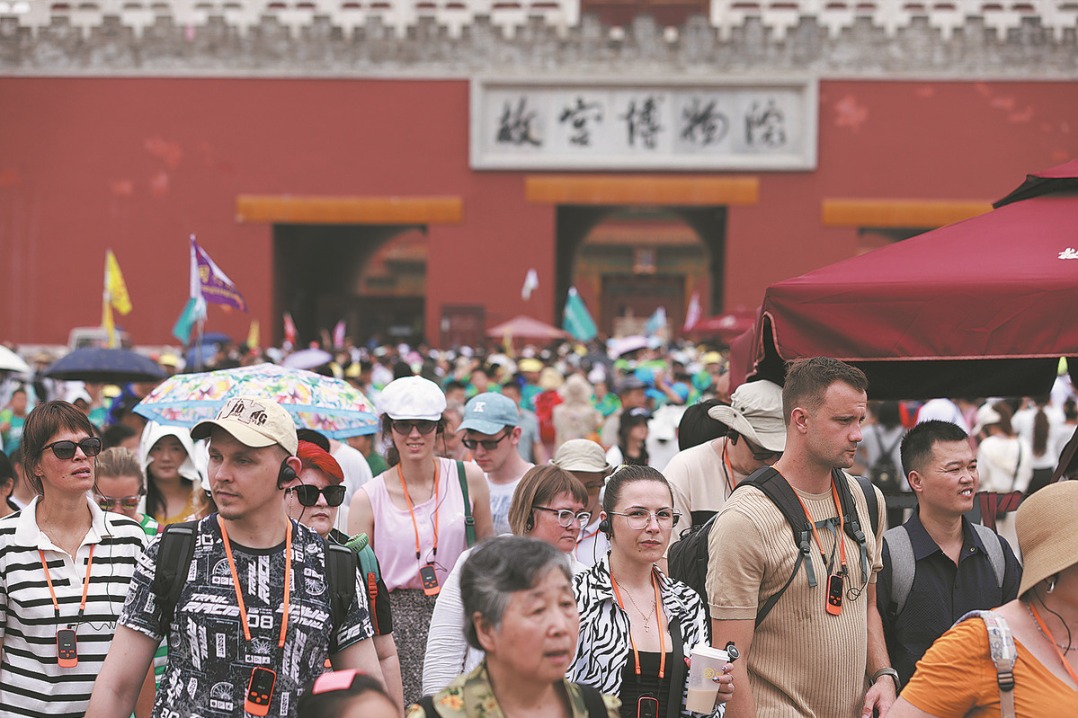Power-balancing diplomacy


Given increasing global conflicts and intensifying competition between the major powers, thriving China-Central Asia relations are a boon for regional stability
Since China and the five Central Asian nations established diplomatic relations 31 years ago, China has made efforts to promote the building of a China-Central Asia community with a shared future.
This has not only improved China's western development strategy and the security environment, but also promoted stability and development of Central Asian countries.
China and Central Asian countries have completely resolved their boundary issues, and effectively coped with all sorts of non-traditional security threats such as terrorism, separatism and extremism through bilateral security cooperation and cooperation under the framework of the Shanghai Cooperation Organization. This has provided them with organizational guarantees to jointly cope with common threats and safeguard regional stability in the years to come.
Economically, the two sides have vigorously taken part in the joint construction of the Belt and Road Initiative, strengthened coordination and cooperation, advanced connectivity, and deepened cooperation in the digital economy, artificial intelligence and e-commerce, laying a solid foundation for future pragmatic cooperation.
China has always been adjusting and improving its Central Asia policy in accordance with changes and practical needs of Central Asian countries. In fact, relations between China and Central Asian countries have witnessed several major historic leaps — from political relations as the mainstay in the initial stage of Central Asian countries' independence to all-round cooperation in political, security, economic and cultural fields; from bilateral cooperation to laying equal stress on bilateral and multilateral cooperation; from good-neighborly and mutually beneficial cooperative relations to strategic partnerships; from the inception of the SCO in 2001 to Chinese President Xi Jinping proposing to build a Silk Road Economic Belt with Central Asian countries when visiting Kazakhstan in September 2013, and then to establishing the "China+Central Asia" (C+C5) cooperation mechanism.
Since the five Central Asian countries restarted multilateral cooperation schemes in 2018, they have held three summits, reaching consensus in many fields and achieving fruitful results. This has highlighted the wholeness of the Central Asian region and the autonomy of regional countries, and created important opportunities for China to promote closer cooperation with Central Asian countries as a whole.
In the meantime, all Central Asian countries have put forward their respective medium- to long-term development strategies, fully displaying their confidence in and determinations to realize a rosy future. They are all actively boosting development, improving the investment climate, bettering the legal system and the economic system, promoting opening to the outside world and striving to boost their economy.
The establishment and smooth functioning of the C+C5 foreign ministers' meeting have injected new vitality into China-Central Asia cooperation. The first C+C5 Foreign Ministers' Meeting was held via video link in July 2020.
The C+C5 cooperation mechanism is a positive response to Central Asian countries' unity for greater strength. Currently, the United States, Russia, the European Union, India and Japan have all established a respective "5+1" cooperation mechanism with the five Central Asian countries.
Meanwhile, the world has entered a period of turbulence with cascading and interlinked crises such as the upheaval in Afghanistan and the Russia-Ukraine conflict, and notably intensifying competition between the major powers. With the regional situation in Central Asia undergoing profound changes, Central Asian states are implementing "major-power balancing "diplomacy to turn it into a place where external forces can carry out benign competition so from which the region can reap benefits.
As the world's second-largest economy, China has gradually become a key variable of changes in the regional situation of Central Asia, triggering complicated, subtle changes to intra-regional relations and China's relations with regional countries. This has posed unprecedented challenges to China's diplomacy toward Central Asia.
On the other hand, the United States has changed its policy toward Central Asia — from mainly containing Russia to containing both Russia and China, even sabotaging Belt and Road projects and hyping up Xinjiang-related issues.
Resolutely abandoning the Cold War mindset and zero-sum game, China has publicly announced that it has no desire to build a sphere of influence in Central Asia or participate in geopolitical competition; instead, China is willing to carry out constructive cooperation with all major powers that have a presence in Central Asia.
China has also been committed to peaceful coexistence with other major powers in Central Asia. This has to the greatest extent mitigated the pressure on Central Asian countries to "take sides", supported them to implement the "major-power balancing" diplomacy, and played a positive role in establishing a new type of major-country relations in Central Asia and defusing the risk of geopolitical conflicts.
China, with a more proactive mindset, should carry forward the successful experience in cooperation with Central Asia countries, meet the challenges and tackle the problems, and make greater efforts in fostering solid and better relations with Central Asian states in the next decade.
To start with, the two sides should further strengthen their consensus on building a community with a shared future.
China and the five Central Asia states, all developing nations, have the same or similar stance on many international and regional issues and face the common tasks of development and boosting the economy. This gives the six countries innate advantages in building a community with a shared future. Second, the two sides should make their cooperation more institutionalized.
Despite the significant progress in cooperation between China and Central Asian states, the efficiency of cooperation falls short of people's expectations due to a lack of effective, legally binding institutional arrangements and guarantees. Thus, China and Central Asian states should jointly improve cooperative mechanisms in customs quarantine control, air traffic control, travel safety, and disaster relief, among others, to ensure that relevant policies are fully implemented.
Third, the two sides should adopt policies that put an equal emphasis on differentiation and wholeness.
Diversification and differentiation are the distinct characteristics of Central Asian states. Targeted cooperation country by country, region by region, and sector by sector, should be promoted.
Given that the Central Asian region is an arena for fierce competition between the world's major powers, they should abide by the basic principles of mutual respect, fairness and justice and mutually beneficial cooperation, to properly handle their relations in the region.
The autonomy of Central Asian states and their desire for intra-regional cooperation are increasing. It is inevitable that the wholeness and localization of the Central Asian region will increase. External forces have put forth their respective plans for revitalizing the Central Asian region, providing new impetus to further boost regional cooperation.
The author is secretary-general at the China Center for Shanghai Cooperation Organization Studies and a research fellow at the China Institute of International Studies. The author contributed this article to China Watch, a think tank powered by China Daily. The views do not necessarily reflect those of China Daily.
Contact the editor at [email protected]
































